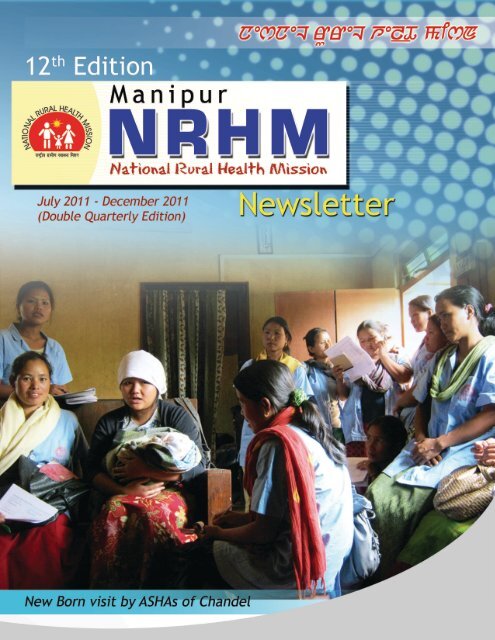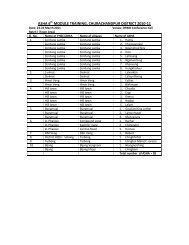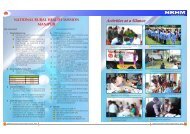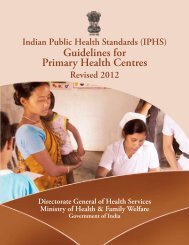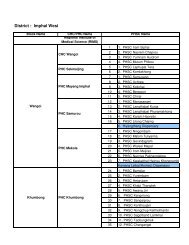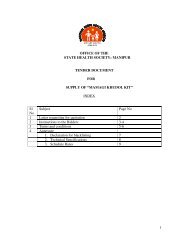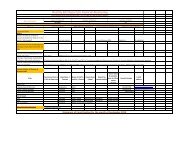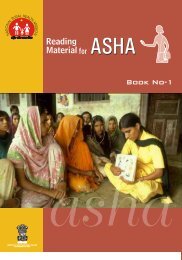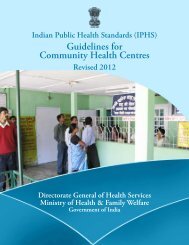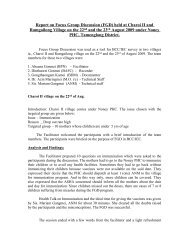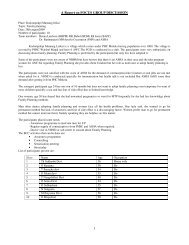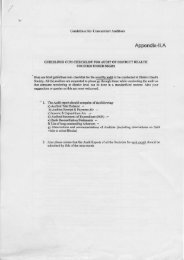cover file.cdr - NRHM Manipur
cover file.cdr - NRHM Manipur
cover file.cdr - NRHM Manipur
- No tags were found...
You also want an ePaper? Increase the reach of your titles
YUMPU automatically turns print PDFs into web optimized ePapers that Google loves.
43Dental counter had the least number ofstudents. 25 students, who were referred fromgeneral medicines and the students whoperceived that they had problems attended thedental counter. Out of the 25 students, only 11were found suffering from caries tooth, 4 withgingivitis with calculus, 2 were suffering fromhypersensitivity teeth, 3 with periodontitis, 1 withstain calculus, 1 with oral ulcer, three weresuffering from tooth ache and 1 with no problemrelated to teeth.Immunization team preparing forimmunisation sessionIEC/BCC SESSION ON HIV/ADS & RTI/STIThe AYUSH team carried outdemonstration on Yoga, awareness onNaturopathy and nature cure and treatmenton Homeopathy medicine to the school childrenand teachers. Total of 172 students wereexamined in the AYUSH counter and freemedicines were also distributed.MACS IEC/BCC team led by Dr. R.K. RosieDevi took the special role of giving healthawareness to the School students. Theyconducted IEC/BCC session on HIV/AIDS todifferent groups of school students. Altogether10 sessions of IEC sessions were conductedgiving full awareness about HIV/AIDS with<strong>NRHM</strong> team distributing free medicines tothe studentsquestion and answer sessions in between. Morethan 20 students participated in a session.Family Welfare Team took theresponsibility of Immunization in collaborationwith Imphal West team and conductedImmunization session for vaccination againsttetanus for the school students and campaignon oral rehydration Solution. 179 studentsincluding both boys and girls were immunizedagainst tetanus.Free medicines were distributed fordifferent ailments to the school students, staffsand also to the senior citizens present on theday of school health camp.<strong>NRHM</strong> Newletter July - December, 2011
445<strong>NRHM</strong> Newletter July - December, 2011
5IMPHAL EASTASHA DAY OBSERVATION23 RD JULY 2011The District Health Society observed the “ASHAs Day” on Saturday 23 rd July 2011 at theoffice premises of the Chief Medical Officer, Imphal East.The dignitaries were:1. M. Lakshmikuma, IAS, Deputy Commissioner /Chairman, District health Society, Imphal East2. Dr. Momota Mukherjee, Chief Medical Officer/Mission Director, DHS, IE3. Dr. K. Rajo Singh, Joint Director, FW services/SNO(ASHA)4. Dr. R. K Tilotama Devi, DFWO/Member Secy. DHS, IE and5. W. IMO Singh, Community Mobilization Consultant, RRC, GuwahatiTo encourage the work done by ASHAs/link workers during the year 2010-2011, the District HealthSociety, IE selected twelve (12) nos of ASHAs and awarded them with a cash prize @ Rs 500 per ASHAand a certificate of achievement in various strategies.Criteria for selection of best ASHAs are as follows:1. Attending VHNDs/promoting immunization2. Supporting institutional delivery/escorting women to the institution3. Household visits4. Fever cases seen/malaria slides made in malaria endemic area.5. Holding VHSC meeting6. Successful referral of the IUD, female sterilization or male sterilization cases7. Management of childhood illness.List of best Asha awarded for the year 2010-2011Sl.No Name Address Health centre1. L. (o) Chandrakala Devi Moirangkampu Sajeb awang leikai PHC Sawombung2. P(o) Rebika Devi Heingang Makha Leikai PHC Heingang3. T. Ranjana Devi Pukhao Naharup CHC Sagolmang4. H. Roma Devi Seijang Makha Leikai PHC Yaingangpokpi5. K. Jamuna devi Lamlai Makha Leikai PHC lamlai6. Wahida Rahaman Kierao Makting Sabal Leikai PHC Keirao Makting7. Chingakham Ibemcha Devi Nongbrang Makha NK8. W(o) Rebika Devi Arapti Mayai Leikai PHC BashikhongC9. Ch. Premabati Devi Andro Khuman PHC Andro10. H. Sakuntala leima Yambem PHC Yambem11. S. Kadam Devi Kongba Uchekon PHC Akampat12. L. IndiraDevi Kongpal Khaidem Leikai Dist. HQ, Porompat<strong>NRHM</strong> Newletter July - December, 2011
66ASHA Day 23 rd July 2011Photos at a glanceDistribution of best ASHAs award for theyear 2010-2011The ASHAs of IE<strong>NRHM</strong> Newletter July - December, 2011
7IMPHAL WESTDISTRICT LEVEL ACTIVITIES DURING THE 2 ND QUATER(July – Sept) 2011Thoibiton, District ProgrammeMangaer,Imphal West Dist.Population Stabilisation fortnight (Servicedelivery Fortnight) 11 th July to 24 th July2011 :Venue & Date of observation SingjameiUHC on 18 /07/2011; Samurou PHC on 20/07/2011; CHC Sekmai on 21/07/2011;Wangoi CHC on 22/07/2011 & Khumbong PHCon 23/07/2011.Acheivement: Number of CuT insertion –148; OCP distributed – 206; Condom distributed– 11,020 and NSV operated – 8 clients.Distribution of Mother’s Package (BabyCarrier and a mug) under BCC/IEC program.Observation of Breast feeding Week at all the12 Health Centres from 1 st to 7 th August 2011Observation of ORS Week at all the 12Health Centres from 23 rd to 29 th July2011.<strong>NRHM</strong> Newletter July - December, 2011
88ACTIVITIES ON MATERNAL DEATH REVIEW:1. One Day Training on MDR (1 st & 2 nd August2011) at CMO Office Building.Expected Participants : Medical Officers ofCHC/PHC and Accredited Private Hospitals.Trainers : Dr. Bimolakumari , CMO I/W ;Dr.Kh Usha DFWO I/W ; N.Thoibiton ,DPMI/WGuest Resource person : Dr.W. Gulapi,SNO/Additional Director, MDR, FW Deptt.2. One day District level Sensitisation programat Deputy Commissioner, IW Office Chamber(27 /08/2011) .Participants : District level Officers of relatedDepartments e.g. ICDS ; PHED ; DIPR ;Education etc. ; DLOs of all vertical HealthProgram & SDO/DBO of Imphal West.3. Half day Sensitization Program of all theSupervisor, ICDS Imphal City Project at CMOOffice Building on 26 /08/2011.RCH camp at KhurkhulRCH camp at PhayengDATE Venue Reason for selecting the venue Name of PHC/CHC OPD30/08/11 Khurkhul PHC Facilitate the patients procedure Khurkhul PHC 170like FP methods.01/09/11 Awang Leikinthabi 5 km away from CHC populated CHC Sekmai 159with emigrants labourers mostlyat quaries.05/09/11 Maklang PHSC Remote area 28 k.m from PHC PHC Phayeng 131Phayeng07/09/11 Uchiwa PHSC Densely populated area PHC Mayang Imphal 24709/09/11 Wangoi Makha A tribal(Kabui) Village Far from CHC Wangoi 121CHC & without PHSC15 /09/11 Khabi Mayai Flood Prone areas & ANMi/c PHC Khumbong 180Leikai Community is on maternity leaveHall<strong>NRHM</strong> Newletter July - December, 2011
912/09/11 Mongsangei UHC To popularise the Services PHC, Mongsangei 250available at newly upgradedUHC.16/09/11 Tendongyang Mainly populated with workers CHC Sekmai 151Community Hall at Brick farm & stone crushing17/09/11 Ningombam Location of these area is Mekola PHC 250isolated from PHC Mekola withbad communication facility.Activities at Block Level:Sl.No Name of Block Details of the Program Date & Venue Analysis/finding1. Wangoi Block BCC Workshop on 19 th Sept.2011 at Sekmaijin Proposed forCommunity InvolvementCommunityin <strong>NRHM</strong>. PRI membersMonitoring;& common VillagersIncreased the Fundfor VHSC &Update theguidelines inconsultationwith the community2. Haorang HMIS Workshop . 12 th July 2011Sabal Block Participants were at Press Club ,ANM; FHS from <strong>Manipur</strong>CHC/PHC & PHSC3 Khumbong Physical & Financial 19 th Sept-22 nd Sept 2011 Some of theBlock Monitoring at 12 PHSC findings are :Kangmong andHeigrujam PHSCsrequire additionalstaffs as it is run bysingle staff( ANM).Heigrujam,Awangjiri andTaobungkhokPHSCs requireattention andinaugration of thesub-centres.Discussion and interaction with the participants atBCC Workshop under Wangoi block<strong>NRHM</strong> Newletter July - December, 2011
1010<strong>NRHM</strong> Newletter July - December, 2011
11CHANDELTENGNOUPAL BLOCK UNDER <strong>NRHM</strong>Tengnoupal block has a population of about17,454. The total number of villages <strong>cover</strong>edby <strong>NRHM</strong> is 69 with 77 ASHAs in position whoare trained in all the training modules andprovided with ASHA kits; the number of VillageHealth & Sanitation committee functioning is 49.Out of 77 ASHAs, there are 28 additionalinducted ASHAs, yet to form Village Health &Sanitation committees.SOME MAJOR ACTIVITIES CONDUCTED SOFAR:• The BPMU Tengnoupal conducted Trainingfor the Old Panchayati Raj Institutions for49 Village chiefs and the newPanchayatiRaj Institutions for 28 chiefs underTengnoupal.• The BPMU Tengnoupal organized andconducted IUCD & RTI/STI Training for 6GNMs/ANMs of Tengnoupal Block on 9th-16th February, 2011 at AimolTampak.Thetraining program was successfullyconducted and seven (7) clients came outfor IUCD insertion during the training itself.• The BPMU Tengnoupal had conductedFGD & 1-Day Workshops for selectedfive villages under Tengnoupal Block,Chandel from 18th February to 1 st March2011. The five villages were Khongkhangvillage, Island village, Chandolpokpi village,Sinam village and Hringkhudam village.• ASHA Training 6 th & 7 th Module programswere conducted in three batches: 1stbatch on 4-7th, 2nd batch on 8 -11th,and 3rd batch on 12-16 th April, 2011 underTengnoupal Block at PDP Hall, Pallel.BPMU, TengnoupalChandel District• The BPMU Tengnoupal conducted One-Day Workshops on “Health ManagementInformation System (HMIS)” for the staffsof PHC and 5 sub-centers at PHC-Tengnoupal on 19 th April and 28 th April,2011.• The BPMU and Medical staffs underTengnoupal Block, observed the PopulationStabilization Fortnight Observation with thetheme: “Small Family - Over alldevelopment”, on 11 th July,2011 at PHC-Tengnoupal, Chandel District.• Breastfeeding Observation Week wasconducted with the theme: “Talk To Me!Breastfeeding - A 3D Experience” on23 rd July, 2011.• Oral Rehydration Solution ObservationWeekwas also organized on 1st August,2011.HEALTH CAMPS:1. DMMU Health Camp was conducted atPHSC-Sita on 3rd February, 2011. Thetotal number of patients was 301. Out ofwhich 207 were females and 194 weremales.2. DMMU Health Camp at Molnoi& adjoiningVillages area on 27 th March, 2011. Out ofthe total turned up of 386 patients, 211patients were females and 195 weremales.3. DMMU Health camp at Aimol Chingnunghutunder PHSC-AimolTampak, on 30 March2011. A total number of 379 patientsturned up for the health camp, out of which194 patients were females and 185 weremales.<strong>NRHM</strong> Newletter July - December, 2011
1212PHOTOS IN NEWS - CHANDELASHA TrainingHome VisitWorkshop at Block LevelMonitoring VisitDMMU CampDMMU Camp<strong>NRHM</strong> Newletter July - December, 2011
13BISHNUPURA REPORT ON THE VULNERABLE POPULATIONPROJECT OF LOKTAK LAKEO. Maipakchao SInghPresident, NGO YUVA, ThangaSponsored by: District Health Society, Bishnupur under National Rural Health MissionSummary Report of the Household Surveydone by YUVA Thanga:1. 100% of the households use unsafedrinking water from Loktak Lake and 100% ofthe household use kerosene for lighting,firewood for cooking and fishing is their onlylivelihood.2. 53.8% of the population are earningmembers out of which 45.37% earn from Rs.1000 to Rs. 2000 per month, 52.35% of themearn from Rs. 2000-Rs. 4000 per month and2.26% of them earn above Rs. 4000 permonth.3. 100% of the population do not havesanitary latrines; they defecate into open LoktakLake itself.4. 100% of the population used boat asthe only means of transportation. 0% of thepopulation own TV, while 24.41 percent ofhousehold have radio at their houses.5.0% of the population has ownagricultural land and livestock.6. At the time of sickness, 85% of thepopulation depend on Govt. health care while15% go to private clinic.7.0.09%, 0.14% and .09% of thepopulation are suffering from T.B., Asthma &Jaundice respectively which not getting propertreatment.Synopsis on problems of Loktak Floating Hutinhabitants:The way of life of the inhabitants of theLoktak Floating Huts (LFH) is unique. Their soleoccupation for livelihood is fishing. These LFHsare scattered here and there in the lake someof them in groups. The availability of safe drinkingwater and environmental sanitation is far fromthe reach of inhabitants. They have very pooraccess to health care facilities.The District Health Mission Society, Bishnupuridentified two areas to provide facilities forhealthy environmental sanitation and to extendthe primary and secondary health care facilities.For Loktak floating huts, inhabitants needaccess to the proper basic health care. Thehabitants go to the nearby villages at a distanceof 4-5 Kms by boat for even a paracetamoltablet. And the situation is worse at the time ofrainy season.So, the innovative programme of vulnerablegroup of peoples residing in Floating Huts atLoktak Lake , <strong>Manipur</strong> under the District HealthSociety, Bishnupur initiated the collection ofWaste Disposal from the service type oflatrines.<strong>NRHM</strong> Newletter July - December, 2011
1414For starting the waste disposal collection ,the organisation engaged 14 volunteers in thebeginning and now 12 nos. of volunteers as perthe approved PIP for the collection of nightsoil for the designated Service type latrinesare in use.At the initial stage, the no. of users of theservice type of latrine were very less in number.They refused to use the latrine. But in themeantime, the rate of users increased. Atpresent, 388 nos. of latrines are functional .Out of total 500 nos. constructed, 112 nos. oflatrines are not functional due to non-repairingafter destruction caused by rain and storms.There is a great demand from the 112 nonfunctionaldwellers for repairing of the latrinesand replacement of the broken buckets in orderto avoid further pollution in the water of theLoktak Lake.COLLECTION OF NIGHT SOILFor smooth functioning of the waste disposalcollection, the area is divided into 4 blocks suchas Southern Block, Central Block, Eastern Blockand Western Block.DISPOSAL(PITS)· Sinusipahai (Private land of Laishram KhunjaoSingh)· Ningthoukhong and· Yangoi Panthon.The pits are <strong>cover</strong>ed with mud from timeto time to avoid unhygienic conditions.MONITORING and SUPERVISIONMonitoring and supervision is beingconducted by a team from the District HealthSociety on regular basis.Also, the 2(two) engaged volunteers strictlylook after the working of 12 volunteers. Theengaged volunteers collect the waste disposalstarting from 6 a.m. and normally end a day’sactivity around 12 noon.OTHER ACTIVITIES· Organised 10 (ten) Health awarenessprogramme in connection to Safe drinkingwater.· Demonstration and training on Chlorinationand uses of alum.· Distribution of Water filter to the hutdwellers.· Regular Health awareness conducted.· Immunisation.MINDSET CHANGE OF THE HUT DWELLERSThe mentality of the hut dwellers havebeen changed. The have developed the habitof using the service type of latrines. At first,the hut dwellers refused to use the floatinglatrines protesting that the latrines are notproper to sit, platforms are shaky and smellsof waste materials etc.DIFFICULTIES IN IMPLEMENTING THEPROGRAMME· In finding areas for digging disposal pits· Weather conditions hampered the mobilityof the volunteers.· Non repairing of the broken structures,bucket etc.<strong>NRHM</strong> Newletter July - December, 2011
15DUMPING ON THE WASTE DISPOSAL PITMODEL OF FLOATING LATRINE AT HUTS.DR. RABINDRA IMPARTING TRAININGTAKING OUT THE NIGHT SOIL BY VOLUNTEERSMONITORING and SUPERVISIONCOLLECTING BY LOCAL BOAT<strong>NRHM</strong> Newletter July - December, 2011
1616<strong>NRHM</strong> Newletter July - December, 2011
17CHURACHANDPURPROGRESS SO FAR IN 2011-12:2 DAYS MCTS/HMIS WORKSHOP:The District Health Mission Societyconducted Sensitization Workshop on Maternaland Child Tracking System Workshop at CMOConference Hall, Churachandpur w.e.f 10-11 thAugust 2011. State Data Manager, District DataManager, Bishnupur, Chief Medical Officer,District Family Welfare Officer, District ProgramD. Khuala Vaiphei, DPMDistrict Health Mission SocietyChurachandpurManagement Unit were the Resource personsand Medical Officers & i/c, Block ProgramManagement Units, Paramedical staffs from 4private Accredited Hospitals, Staffsrepresentative from District Hospital, CHC, PHC& PHSCs attended the workshop.Inauguration of Labour Room & DesignatedTB Microscopic Centre at PHC Saikot:The District Health Society, Churachandpurinaugurated PHC Saikot Labour Room and TBDesignated Microscopic Centre on the 12 th May2011. The Labour room was inaugurated by MsJacintha Lazarus, Deputy Commissioner/Chairperson, District Health Mission Society,Churachandpur and TB Microscopic Centre wasinaugurated by State TB Officer.DMMU Camp at Charoikhullen SC on 18 thSept 2011:The District Health Mission Society,Churachandpur kicked-off its first DMMU Campfor the year 2011-12 at SC Charoikhullen underHenglep Block on 8 th Sept 2011. Six Doctors, 6Nurses, 2 Pharmacists, One Eye Opthalmist, ICTC,Malaria Dept, Block Program Management Unitof Henglep and ASHAs of surrounding villages<strong>NRHM</strong> Newletter July - December, 2011
1818participated in the camp. A totalof 311 patients were examinedduring the camp. Free Medicinewere distributed. The DistrictMission Director, District FamilyWelfare Officer, District ProgramManagement Unit, Village Chiefsof surrounding areas attended thecamp.Inauguration of Labour Room & TB Centreat PHC SaikotDMMU Camp at Charoi Khullen (18th Sept. 2011)<strong>NRHM</strong> Newletter July - December, 2011
19TAMENGLONGSTORY OF AN ASHA OF KAHULONG VILLAGE- AbuanaDPM, TamenglongDayliu Rongmei, wife of Mr. Duanpuanang Rongmei is a 28 years old woman working as anASHA in Kahulong village. The village has about 90 households with a total population of around883 people and is located about 18 kms from the District Hospital, Tamenglong. The village is<strong>cover</strong>ed by Primary Health Sub Center Akhui which is manned by only 1 ANM.Dayliu is 10+2 passed and a mother of three children and has been working as an ASHA forthe past 4(four) years. She has received training up to the 1 st round of 6 &7 ASHA Module book.She is a very smart and dynamic health worker who works for her community with full zeal andenthusiasm. Her works are greatly appreciated by her community, both young and old. Shebridges and links the gap between her village and the health facility by accompanying the sick,including children and the pregnant women for health checkups to the PHSC as well as to theDistrict Hospital.Dayliu Rongmei is nominated as a Best ASHA by The Village Health & Sanitation Committeeof the village which was formed in the middle of 2007. The details of the membership and theactivities of The Village Health and Sanitation Committee are given below:a) No. of meetings held during 2010-11 : 3 timesb) No. of VH&ND held during 2010-11 : 10 timesc) VHSC fund received : 4 timesd) Maintenance of records : Delivery, ANC, Immunization,NISCHAY, RDK, VH&ND, VHSCaccount registerse) No. of JSY beneficiaries in the village : 11 during 2010-11 (besidesaccompanying other pregnant womenfor delivery who is not a JSYbeneficiary)f) No. of incentives received : 3 during 2010-11Successes of <strong>NRHM</strong>:1. “Before the implementation of <strong>NRHM</strong>, pregnant mothers do not go for ANC. But throughthe various programmes of <strong>NRHM</strong>, awareness level has not only increased but every pregnantmother makes it a point to visit the Primary Health Sub Center/District Hospital for ANC checkups”says Dayliu Rongmei (ASHA) proudly.2. Immunization of children has also improved considerably with the coming of <strong>NRHM</strong>. TheASHA mobilizes the mothers from locality to locality as the village is divided into four parts, tobring their children for immunization.<strong>NRHM</strong> Newletter July - December, 2011
20201. More hygienic in home deliveries (as theTrained Birth Attendants have started using handgloves during deliveries)2. “I am able to give first aid measures forsome minor ailments and injuries and I was alsotrained by the M.O i/c of DH to take BPmeasurement. I am now able to visit the sickand take BP measurements and give advices tothem in time. People of my village now takemy advice on health matters and I am happythat I am able to do something for mycommunity” says Dayliu Rongmei (ASHA).3. ‘I am able to motivate mothers for FamilyPlanning and has brought about 8 mothers inthe Sterilization camp at the DH and has so farmotivated about 150 women for IUD insertionand I got my incentives accordingly’.Issues & Problems/Suggestions:1. At present, there is a jeep runningbetween the village and the District. But thisjeep service runs depending on the number ofpassengers and is does not operate beyondthe highway during the rainy season.2. The villagers now depend on the ASHAfor medicines for any ailments/emergencydeliveries thereby rendering the ASHA helplessat times. It is suggested that ASHA Drug kits bereplenished twice a year.3. ‘Sometimes, I could not do my householdchores and I feel bad before my husband andin-laws’.4. The village is divided into four parts,about 2 kms from each other thereby making itdifficult for the ASHA to mobilize children andmothers during immunization and VH & NDs. TheVH & SC is now demanding for 1 additionalASHA for the smooth implementation of healthprograms.5. Some patients who are very poor donot have the fare to go for checkups to the DHand sometimes ask the ASHA for the fare andshe has to give from her own pocket.6. ‘I cannot always accompany the sick tothe health center as I have my own limitationstoo and sometimes I feel guilty about it’.7. Increase the package of ASHA logisticsupport to at least Rs 400/- for difficult districtlike Tamenglong as ASHAs working in this districthas to face a lot of transportation/lodgingproblems as they halt in hotels sometimes fordays when they accompany the pregnantmothers for delivery.<strong>NRHM</strong> Newletter July - December, 2011
23THOUBALLilong Block ASHA Day on 23rd September 2011at Lilong Higher Secondary MadrassaObservation of ASHA Day-Lilong Block on 23rd September 2011at Lilong Higher Secondary MadrassaObservation of ASHA Day-Lilong Block on 23rd September 2011at Lilong Higher Secondary Madrassa<strong>NRHM</strong> Newletter July - December, 2011
2424Inauguration ceremony of computerized OPD ticketingsystem in District Hospital - thoubal on 15th July 2011Inauguration ceremony of computerized OPD ticketingsystem in District Hospital - thoubal on 15th July 2011Inauguration of barrack type quarter(BTQ) and Functioningof 24X7 services at PHC Lilong on 20th September 2011<strong>NRHM</strong> Newletter July - December, 2011
25Tally ERP Training for District and Block Finance Managers at The Classic Hotel from 26Aug., 2011 to 8th Sept., 2011<strong>NRHM</strong> Newletter July - December, 2011
2626ASHASince its inception in the year 2006 in<strong>Manipur</strong>, ASHA, the foot soldiers of <strong>NRHM</strong> whotakes on the entire responsibility of the Missionat the grass root level of the machinery has sofar played a pivotal and crucial role in achievingthe objectives of the Mission. Keeping this factin mind, it is imperative that the Mission givesequal importance in monitoring and empoweringits ASHAs. Empowerment has to be on an ongoingbasis and on a continuous evidence based needassessment both for ASHAs and thebeneficiaries.Apart from imparting focused trainingprograms, ASHAs have been continuouslyempowered so far by providing them variousitems which are considered necessary in light ofdelivering their services both effectively andefficiently.So far in terms of empowering the ASHAs,the Mission has been providing them with thefollowing items:- Umbrella- ASHA drug kit- Radio- Bicycle (4 valley districts whereas in 5hill districts ASHAs are giving Rs.200every month as transportation charge)- Uniform- Diary- ID Card- Torch Light (Process)- Weighing machine- Digital thermometer- Digital Watch- Mobile phones and Raincoats arecurrently under process.Now, in order to make the entire systemmore efficient, the Mission is planning to introducea new catalyst to induce efficiency in the formof the Mother and Child Tracking Systempopularly known as the MCTS.Although the Mission provides for increasedsafety of Mothers and Newborns, many timesit has been found that Maternal and Infant deathswere reported due to sheer negligence on thepart of the beneficiaries such as skipping antenatalcheckups, neglecting the prescribedsupplements during pregnancy such as IFA, TTetc. Thus, the Mission has a situation in hand inwhich the system finds itself falling short in termsof monitoring and ensuring compliance from thebeneficiaries. In order to tackle this situation,the Mission is contemplating to use the MCTS sothat a fool proof system is in place where thesystem itself guarantees efficiency andeffectiveness as much as possible.In terms of enforcing the ASHAs, periodiccheckups of beneficiaries can be informed tothe ASHAs well in advance as a reminder so asto ensure that the beneficiaries stick to theirprescribed programs. This empowerment will atthe same time induce a certain amount ofaccountability to the ASHAs in terms ofresponsibilities so as so enable concernedauthorities in monitoring their performances.By :-Harris S. ChongthamState ASHA Program Manager<strong>NRHM</strong>, <strong>Manipur</strong><strong>NRHM</strong> Newletter July - December, 2011
27National Rural Health MissionProgress so far......National Rural Health Mission (<strong>NRHM</strong>)Background:National Rural Health Mission (<strong>NRHM</strong>) waslaunched in the country on 12th April 2005 bythe Hon'ble Prime Minister with special focus to18 High Focus States including the State of<strong>Manipur</strong>.Vision:(i) To provide accessible, affordable andquality health care to the rural population,specially the vulnerable sections(ii) To increase public spending on health from0.9% of GDP to 2-3% of GDP by end ofMission period (2012)(iii) To undertake architectural correction ofthe health system to enable it effectivelyhandle the increased allocations andpromote policies that strengthen publichealth management and service delivery(iv) Effective integration of health and familywelfare sector with health determinantsectors such as sanitation, water supply,nutrition, gender and social sectors(v) To improve access by the rural peopleespecially poor women and children toequitable, affordable, accountable andeffective primary health care.Objectives:(i) Reduction in child and maternal mortality(ii) Universal access to food and nutrition,sanitation & hygiene and universal accessto public health care services(iii) Prevention and control of communicableand non-communicable diseases(iv) Access to integrated comprehensiveprimary health care(v) Population stabilization, gender anddemographic balance(vi)(vii)Revitalize local health traditions andmainstream Ayurved, Yoga & Naturopathy,Unani, Siddha and Homeopathy (AYUSH)Promotion of healthy life stylesComponents:Part A : Reproductive & Child Health Phase IIand Family Planning ProgramsPart B : New components/ additionalities e.g.provision of untied fund to HealthInstitutions.Part C : Routine Immunization strengtheninginterventionsPart D : All National Health Programs (e.g., TB,Leprosy etc.) and Integrated DiseaseSurveillance ProgramPart E : Convergence of activities with healthdeterminant sectors e.g., safe drinkingwater supply, sanitation, education,ICDS etc.Core strategies:(i) Train and enhance capacity of PRI to own,control and manage public health services(ii)(iii)(iv)(v)(vi)Promote access to improved health careat household level through AccreditedSocial Health Activists (ASHAs)Health plan for each village through VillageHealth Committees of the PanchayatStrengthening existing health facilitiesthrough better staffing and HRD Policy,clear quality standards, better communitysupport and an untied fund to enable thelocal management committee to achievethese standardsDecentralization in planning, implementationand monitoringIntegrating vertical Health and FamilyWelfare Programs at National, State,District and Block levels<strong>NRHM</strong> Newletter July - December, 2011
2828(vii) Developing capacities for preventivehealth care at all levels for promotinghealthy life style, reduction in consumptionof tobacco and alcohol etc.(viii) Promoting non-profit sector for PublicPrivate Partnership for rendering healthservices in under-served areasState's responsibility:(i) 10% annual increase in yearly healthbudget(ii)15% matching State Share of the totalannual <strong>NRHM</strong> budget ( from 2006-07onwards)(iii) Signing of MoU indicating both physicaland financial achievementsState's Progress so far:Organizational set up:-(i) Formation of State Health Mission underthe chairmanship of Hon'ble Chief Minister,<strong>Manipur</strong>(ii)(iii)(iv)(v)(vi)Formation of registered State HealthSociety under the chairmanship of ChiefSecretary, Govt. of <strong>Manipur</strong> by mergingall vertical health and family welfareprograms (except Cancer Control andHIV/AIDS)Formation of similar structures at DistrictlevelRogi Kalyan Samiti, which are autonomoussocieties are established at JN Hospital,07 District Hospitals, 16 CHCs and 73 PHCs.Formation of 420 Sub-Centres levelCommittee led by PRI representative forall existing Sub-Centres in the StateFormation of registered Village Health &Sanitation Committees led by PRIrepresentative for all villages/ hamlets.3591 Village Health & sanitationCommittees are operationalized with theirown bank accounts.Accredited Social Health Activists (ASHAs):-• Umbrella, ASHA drug kit, Radio, Bicycle,Uniform, Pass Book, ID Card, TorchLight,Weighing machine, Digitalthermometer, Digital Watch.• Mobile phones and Raincoats arecurrently under process.• 3878 ASHAs engaged in the state of<strong>Manipur</strong>.• ASHA training: modules 1 to 5 have beencompleted in all the districts and modules6 & 7 (2nd round) have been completedin all the districts except for the districtof Ccpur.• ASHA state facility cum help desk havebeen introduced in four districts of IE,IW,BPR and Ukl.<strong>NRHM</strong> Newletter July - December, 2011
29(i)(ii)(iii)Establishing Program Management Support Units (each unit comprising of Program Manager,Finance Manager and Data Manager) at the levels of State, District and BlockRecruiting and posting of Finance cum Account Officers in PHCsFilling up technical manpower gaps as per Facility Survey Report (19 MOs, 14 PublicHealth Nurses, 140 GNMs, 465 ANMs, 48 Laboratory Technicians, 13X-Ray Technician,88 AYUSH Doctors, 25 AYUSH Pharmacists, etc.Human Resources:-Trainings:-Skills, knowledge & Practice of MOs, Nurses & Paramedics are up-graded by training themon ….(2011-12)Sl. No. Trainings Target Ach. (till Nov'11) Remarks1 Skilled Birth Attendant (SBA)• Staff Nurses 2 4 2 4• AYUSH MOs 2 0 04 undergoing2 Basic Emergency Obstetric Care(BEmOC) 2 4 8 ongoing3 Blood Storage• MOs 8 8• Lab. Technician 6 64 Navjaat Shishu Surakhsha karyakram 100 8 6(NSSK)5 Adolescent Reproductive & Sexual 61 Mos 6 1Health (ARSH)6 Post Graduate Diploma In public 2 2 ongoing underHealth (PGDPHM)PHFI DelhiThe following graphs shows the outcome of Training imparted to nurses on SBA-<strong>NRHM</strong> Newletter July - December, 2011
3030Immunization:-Regarding immunization, auto disabled syringes are used for vaccination. Yearwise progresssince the inception of <strong>NRHM</strong> in the State-Family Planning:-Performance of family Planning Services so far-Planning process:-• 2005-06 - State Program Implementation Plan (SPIP) prepared at State level• 2007-08 - SPIP formulated based on District Health Action Plans prepared byDistricts• 2008-09 - SPIP based on Block and District Health Action Plans• 2009-10 - SPIP preparation to be started with Village Health Action Plans• 2010-11 - SPIP prepared based on 10% of the villages, Blocks and Districts• 2011-12 - SPIP prepared based on 25% of the villages, Blocks and DistrictsInfrastructure development:-• Construction of 12 Institutional Building and 09 Barrack Type Quarter• Repairing of OT and LR of 07 DHs and 04 CHCs to be upgraded as FRUS<strong>NRHM</strong> Newletter July - December, 2011
31• Upgradation of CHCs• Construction of 11 Buildingless relocated Sub-Centres• Setting of mini training centre at BPR, TBL,UKL,CDL, CCP, SPT & TML• Construction of Incinerator at UKL, CDL, CCP, SPT & TMLAnnual fund to Health Institutions:-Types District CHC/SDH PHC Sub Centre VHSCHospital/SHRs. In lakhsCorpus Grant 5 1 1 0 0Annual 0 1 0.5 0.1 0GrantMaintenanceUntied Fund 0 0.5 0.25 0.1 0.1Total 5 2.5 1.75 0.2 0.1Adolescent Reproductive & Sexual Health (ARSH):-• 29 TOT conducted in 2010-11• 52 MO & 6 peer educators trained on ARSH 2011-12• AFHC in the institutes attached with ICTC centers are under process• Weekly Iron Folic Acid Supplementation to begin from next year• Health check up done:o CDL-6 schoolso IW-3 schoolso SPT-20 schoolso State cell 37 schools<strong>NRHM</strong> Newletter July - December, 2011
3232BCC/IEC : -Creating awareness & Changing Behavior, Reaching the Unreached through…• 64 RCH Camps & 87 DMMU Camps at vulnerable & remote areas• Ads, Tele Film, Group Discussions, Radio Jingles, Health Talks• Erection & maintenance of hoardings• Annual Calendar published• Printing of leaflets• Quarterly newsletters• Road Signs• Gifts Package to mothers for promoting Institutional DeliveryPNDT:-• State Level Sensitization workshop for Women NGOs (28th June, 2011 at Moreh)• Workshops for Advocates/Public Prosecutors (21st August, 2011 at Cheirap Imphal)• Workshops for Gynaecologists/Doctors(17th Sept, 2011 at RIMS)• 4 awareness programs(Moirang purel, Pishum, Bijoy Govinda, Tera)• Inspection of Ultra sound Clinics<strong>NRHM</strong> Newletter July - December, 2011
33Institutional Delivery :-Increasing Trend - one of factor for reducing MMR Also improve due to implementaion ofJanani Surakhsha Yojana (JSY) in the State.JSSK ( Janani Suraskha Karyakram):-• launched on 15th August in the State by Hon'ble Chief Minister.• Entitlements for Pregnant Women:o Free deliveryo Free caesarean sectiono Free drugs and consumableso Free diagnostics (Blood, Urine tests and Ultrasonography etc.)o Free diet during stay (upto 3days for normal delivery and 7dayso for caesarean section)o Free provision of bloodo Free transport from home to health institution, between health institutions in case ofreferrals and drop back homeo Exemption from all kinds of user charges• Entitlements for Sick Newborn till 30 days after birth:o Free and zero expense Treatmento Free drugs & consumableso Free diagnosticso Free provision of bloodo Free transport from home to health institution, between health institutions in case ofreferrals and drop back homeo Exemption from all kinds of user charges<strong>NRHM</strong> Newletter July - December, 2011
3434Status:• Identification of State Nodal Officer and District Nodal Officer in placed• Notification/ Assurance of NIL out of pocket expenses in all govt. health facilities is notplaced.• This year 2012-13 in State Action Plan, the plan of action will be put up.Public Private Partnership (PPP):-• Running three inaccessible PHCs namely PHC Tousem & PHC Borobekra with an experiencedNGO (KARUNA Trust)• PPP for Emergency Obstetric Care with Comprehensive Health Services & ResearchCentre (CHSRC), Hamleikhong East, Ukhrul DistrictAmbulance For Difficult Terrain Areas:-Four Wheel Drive ambulance suitable for hilly areas provided to DH Senapati, Tamenglong,Churachandpur, Chandel, CHRSC Ukhrul & CHC JiribamSolar Power Plant:-• Back up Power Supply• Solar back up of 25KW installed in Moreh hosp., DH Ccpur in convergence withMANIREDA• On process for installing of DH Thoubal• Already tie up with MANIREDA for installing in remaining 05 DHsMother & Child Tracking System (MCTS):-Objective of MCTS :To ensure that -• every pregnant woman receive• Full Ante-Natal Care Check-ups (ANCs) ,• Post-natal care (PNCs) including JSY payments• every child receive full immunization/vaccinationImplementation Status :• Initially implemented in Bishnupur district• Operationalised in Thoubal, Imphal East, Imphal West & Churachandpur(DHQ)• Remaining hill districts to follow in 2012-13.Registration Count as on 5th January 2012 :• 2888 pregnant woman & 1657 infants enrolled under Mother & Child care programunder MCTS• Mapping of all health facilities completed• 752 ASHAs & 224 ANMs registered in MCTS<strong>NRHM</strong> Newletter July - December, 2011
35AYUSH:- An alternative treatment….• Mainstreaming of AYUSH" by collocation of services with Allopathy• Provide choice of treatment to the patients.• Strengthen facility functionality.• Strengthen implementation of the National Health Programs• 61 Homeo.,09 Yoga & Nature care, 05 Unani, 14 Ayurveda & 25 Pharmacists arecollocated in DHs, CHCs & PHCs<strong>NRHM</strong> Newletter July - December, 2011
3636Major procurement activities :• Under Procurement, drugs have arrived from TNMSC to Imphal and supplied to districts.• In order to avoid wastage of drugs/medicine, an indent basis has been started with inputsfrom district and an exercise on the essential drug list as per the requirements of thedistricts are currently being worked on before the next order is placed to TNMSC.• Further for proper storage of drugs at State and District level, Ministry has been requestedfor building one warehouse at each district and one at State Level.• Medical equipments to the tune of Rs 3.7 crore have been supplied to District Hospital,TBL and CCPR. Procurement of equipment & furniture gaps in DHs in Thoubal, CCPR tothe tune of Rs 3.43 crore currently underway.E-banking being initiated for the first time in <strong>Manipur</strong> through <strong>NRHM</strong> :• Through E-banking:• Immediate and complete information to be made available regarding numerous bankaccounts under <strong>NRHM</strong> in the state, district, block etc• Information on treasury route flows• Sanction order wise information on expenditure and advances• Aging of advances• Backward and high focus districts unspent balances and fund utilization details readilyavailable• Expenditure trending information in real time will be available Facility wise and level wise• Abnormalities or red flags in expenditure patterns can be easily detected or detected intime• Information readily available on payments to• Beneficiaries• Third Party Payments• Asha incentive payments• SHS, DHS etc can find out particular details regarding identified transactions easilyFeatures:-• A web enabled portal, work online or offline and with or without a standard accountingsoftware• This will enable linking up on a single platform all the financial transactions right from thePHCs level to the block, district and SHS level.• Rolled out on a pilot basis at Imphal East District and State Head Office with real timelinked up planned within 3 months.<strong>NRHM</strong> Newletter July - December, 2011
371. Janani Suraksha Yojana (JSY) is a safe motherhood intervention under the National Rural HealthMission (<strong>NRHM</strong>) being implemented with the objective of reducing maternal and neo-natal mortalityby promoting institutional delivery among the poor pregnant women.2. JSY integrates cash assistance with delivery and post-delivery care. The success of the scheme wouldbe determined by the increase in institutional delivery among the poor families.3. Role of ASHA or other link health worker associated with JSY would be to:• Identify pregnant woman as beneficiary of the scheme and report or facilitate registration forANC,• Assist the pregnant woman to obtain necessary certifications wherever necessary,• Provide and / or help the women in receiving at least three ANC checkups including TT injection,IFA tablets.Identify a functional Government health centre or anaccredited private health institution for referral and delivery‣ Counsel for institutional delivery,‣ Escort the beneficiary women to the pre-determinedhealth centre and stay with her till the woman is discharged,‣ Arrange to immunize the newborn till the age of 14 weeks,‣ Inform about the birth or death of the child or mother tothe ANM /MO,‣ Post natal visit within 7 days of delivery to track mother’shealth after delivery and facilitate in obtaining care,wherever necessary.‣ Counsel for initiation of breastfeeding to the newbornwithin one-hour of delivery and its continuance till 3-6months and promote family planning.Note: Work of the ASHA or any link worker associated with Yojana would be assessed based on thenumber of pregnant women she has been able to motivate to deliver in a health institution and thenumber of women she has escorted to the health institutions.<strong>NRHM</strong> Newletter July - December, 2011
3838<strong>NRHM</strong> Newletter July - December, 2011
39Janani Shishu Suraksha Karyakram ( JSSK )Assures NIL out of pocket expenses in all Government Health Institutions For Pregnant Women& NewbornEntitlements for Pregnant Women as set by the Ministryo Free deliveryo Free caesarean section at District Hospitalso Free drugs and consumableso Free diagnostics (Blood, Urine routine for sugar and protein, Haemoglobin test,pregnancy test etc.)o Free diet during stay (up to 3days for normal delivery and 7 days for caesareansection) only at govt. Hospitals except RIMS and JNIMSo Free provision of blood at FRU/ District Hospitalso Free transport from home to nearest delivery points/health institution, between healthinstitutions in case of referrals and drop back homeo Exemption from all kinds of user chargesEntitlements for Sick Newborn till 30 days after birth:o Free and zero expense treatmento Free drugs and consumableso Free diagnosticso Free provision of blood at FRU/ District Hospitalso Free transport between nearest health facilities in case of referral and Drop backfrom nearest health institutions to homeo Exemption from all kinds of user charges<strong>NRHM</strong> Newletter July - December, 2011
4040<strong>NRHM</strong> Newletter July - December, 2011
41IPHS Norms of a Sub-CentreIntroduction:In the public sector, a Sub-health Centre(Sub-centre) is the most peripheral and firstcontact point between the primary health caresystem and the community. As per the populationnorms, one Sub-centre is established for every5000 population in plain areas and for every3000 population in hilly/tribal/desert areas. Itis the lowest rung of a three-tier set up consistingof the Sub-centre established for every 3000-5000 population with referral linkage to thePrimary Health Centre (PHC) for 20,000 –30,000 population, and the Community HealthCentre (CHC) for 80,000 to 1,20,000population.A Sub-centre provides interface with thecommunity at the grass-root level, providing allthe primary health care services. Of particularimportance are the packages of services suchas immunization, antenatal, natal and postnatalcare, prevention of malnutrition and commonchildhood diseases, family planning services andcounselling. They also provide elementary drugsfor minor ailments such as ARI, diarrhea, fever,worm infestation etc. and carryout communityneeds assessment. Besides the above, thegovernment implements several national healthand family welfare programmes which againare delivered through these frontline workers.Currently a Sub-centre is staffed by oneFemale Health Worker commonly known asAuxiliary Nurse Midwife (ANM) and one MaleHealth Worker commonly known as MultiPurpose Worker (Male). One Health Assistant(Female) commonly known as Lady Health Visitor(LHV) and one Health Assistant (Male) locatedat the PHC level are entrusted with the task ofsupervision of all the Subcentres (generally sixsubcentres) under a PHC. The Ministry of Health& FW, GOI provides assistance to all the Subcentresin the country since April 2002 in theform of salary of ANMs and LHVs, rent (iflocated in a rented building) andcontingency, inaddition to drugs and equipment kits. The salaryof Male Health Worker is borne by the StateGovernments. As of September 2004, a totalof 1,42,655 sub-centres are functional in thecountry. About half of the Sub-centres arelocated in Government buildings. The rest areeither in rented buildings or in rent-freePanchayat / Voluntary Society buildings. Nearlyhalf of the sub-centres do not have a male healthworker. As sub-centres are the first contact pointwith the community, the success of any nationwide programme would depend largely on wellfunctioning subcentres providing services ofacceptable standard to the people. This wouldalso have an impact on the reduction of maternaland infant mortality. Recent studies have shownthat ensuring their accessibility and availabilityof quality primary health care services to thecommunity through these sub-centres are majorconcerns. The launch of National Rural HealthMission has provided the opportunity to have afresh look at their functioning.There is a felt need for quality managementand quality assurance in health care deliverysystem so as to make the same more effective,economical and accountable. This can beachieved only if certain standards and guidelinesare available. Although there has been someguidelines for the Sub-centres in piece meals,no concerted effort has been made so far toprepare comprehensive standards for the Subcentres.In order to provide Quality Care in theseSubcentres, Indian Public Health Standards (IPHS)are being prescribed to provide basic primaryhealth care services to the community andachieve and maintain an acceptable standardof quality of care. These standards would helpmonitor and improve functioning of the subcentre.Setting standards is a dynamic process.Currently the IPHS for Sub-centres has beenprepared keeping in view the resources availablewith respect to functional requirement for Subcentreswith minimum standards, such as building,manpower, instruments and equipments, drugsand other facilities etc.<strong>NRHM</strong> Newletter July - December, 2011
4242Objectives of Indian Public Health Standards (IPHS) for Sub-centresThe overall objective of IPHS is to provide health care that is quality oriented and sensitiveto the needs of the community. The objectives of IPHS for Sub-Centres are:i. To provide basic Primary health care to the community.ii. To achieve and maintain an acceptable standard of quality of care.iii. To make the services more responsive and sensitive to the needs of the community.3. Minimum Requirement (Assured Services) to be provided in a Subcentre:Sub-centres are expected to provide promotive, preventive and few curative primary healthcare services as below:3.1 Maternal and Child Health:(i) Antenatal care:• Early registration of all pregnancies, ideally within first trimester (before 12th week ofPregnancy). However even if a woman comes late in her pregnancy for registration, sheshould be registered and care given to her according to gestational age.• Minimum three antenatal check-ups: First visit to the antenatal clinic as soon as pregnancy issuspected/between the 4th and 6th month (before 26 weeks), 2nd visit at 8th month(around 32 weeks) and 3rd visit at 9th month (around 36 weeks)• Associated services like general examination such as height, weight, B.P., anaemia, abdominalexamination, breast examination, Folic Acid Supplementation in first trimaster, Iron & FolicAcid Supplementation from 12 weeks, injection tetanus toxoid, treatment of anaemia etc.,(as per the Guidelines for Antenatal care and Skilled Attendance at Birth by ANMs andLHVs)• Minimum laboratory investigations like haemoglobin estimation, urine for albumin and sugar,and referral to PHC for blood grouping.• Identification of high-risk pregnancies and appropriate and prompt referral.• Malaria prophylaxis in malaria endemic zones as per the guidelines of NVBDCP.• Counselling on diet & rest, pre birth preparedness and complication readiness, delivery kitfor home deliveries, danger signs, infant & young child feeding, initiation of breast feeding,exclusive breast feeding for 6 months, demand feeding, supplementary feeding (weaningand starting semi solid and solid food) at 6 months, contraception, advice on institutionaldeliveries, clean and safe delivery at home, postnatal care & hygiene, nutrition, care ofnew born and registration of birth.(ii) Intra-natal care:• Promotion of institutional deliveries• Skilled attendance at home deliveries when called for• Appropriate and prompt referral(iii) Postnatal care:• A minimum of 2 postpartum home visits, first within 48 hours of delivery, 2nd within 7 to 10days.<strong>NRHM</strong> Newletter July - December, 2011
43• Initiation of early breast-feeding within half-hour of birth• Counselling on diet & rest, hygiene, contraception, essential new born care, infant andyoung child feeding. (As per Guidelines of GOI on Essential newborn care) and STI/RTIand HIV/AIDS(iv) Others:• Provision of untied fund to the Sub-centres (currently Rs.10,000 per Subcentre is providedunder <strong>NRHM</strong>) for facilitating the service management at the Sub-Centre.• Provision of facilities under Janani Suraksha Yojana (JSY)Child Health:• Essential Newborn Care (maintain the body temperature and prevent hypothermia, maintainthe airway and breathing, the baby should be breastfed by the mother within half-an-hour, takecare of the cord, and take care of the eyes, as per the guidelines for Ante-Natal Care andSkilled Attendance at Birth by ANMs and LHVs.)• Promotion of exclusive breast-feeding for 6 months.• Full Immunization of all infants and children against vaccine preventable diseases as perguidelines of GoI.• Vitamin A prophylaxis to the children as per guidelines.• Prevention and control of childhood diseases like malnutrition, infections, ARI, Diarrhea,Fever, etc.3.2 Family Planning and Contraception3.2.1 Education, Motivation and counseling to adopt appropriate Family planning methods3.2.2 Provision of contraceptives such as condoms, oral pills, emergency contraceptives, IUDinsertions (Wherever the ANM is trained on IUD insertion)3.2.3 Follow up services to the Eligible couples adopting permanent methods (Tubectomy /Vasectomy)3.3 Counseling and appropriate referral for safe abortion services (MTP) for those inneed.3.4 Adolescent health care:3.4.1 Education, counselling and referral3.5 Assistance to school health services.3.6 Control of local endemic diseases such as Malaria, Kala azar, Japanese Encephalitis,Filariasis, Dengue etc and control of Epidemics3.7 Disease surveillance3.8 Water Quality Monitoring:3.8.1 Disinfection of water sources3.8.2 Testing of water quality using Rapid Test (Bacteriological)3.9 Promotion of sanitation including use of toilets and appropriate garbage disposal.3.10 Field visits<strong>NRHM</strong> Newletter July - December, 2011
444Manpower requirement:In order to provide above services, each subcentre should have the following personnel:Manpower Existing ProposedHealth worker (female) 1 2Health worker (male) 1 1 (funded andappointment by the stategovernment)Voluntary worker to keep 1(optional) 1(optional)the Sub-centre clean andassisting ANM. She isPaid by the ANM fromher contingency fund @Rs.100/pmTotal 2/3 3/4Note: The staff of the Subcentre will have the support of ASHA (Accredited Social HealthActivists) wherever the ASHA scheme is implemented / similar functionaries at village level inother areas. ASHA is primarily a trained woman volunteer, resident of the village-married/widow/divorced with formal education up to 8th standard preferably in the age group of 25-45years. The general norm is one ASHA per 1000 population. The job functions of ANM, MaleHealth worker, ASHA and AWW in the context of coordinated functions under <strong>NRHM</strong>.Physical Infrastructure:A Sub-centre should have its own building. If that is not possible immediately, the premiseswith adequate space should be rented in a central location with easy access to population.5.1 Location of the Centre: The location of the sub-centre should be so chosen that:i) It is not too close to an existing subcentre/PHCii) As far as possible no person has to travel more than 3 km to reach the Sub-centre.iii) The Sub-centre village has some communication net work (road communication/public transport/post office/ telephone)iv) Accommodation for the ANM/ male health worker will be available on rent in the village ifnecessary. For selection of villages under the sub-centre, approval of Panchayat as may beconsidered appropriate is to be obtained.5.2 The minimum <strong>cover</strong>ed area of a Sub-centre along with residential quarter for ANM will varyfrom 73.50 to 100.20 Sq.Mts. depending on climatic conditions (hot & dry climate, hot andhumid climate, warm and humid climate), land availability, and with or without a labour room.A typical layout plan for Sub-centre with ANM residence as per the RCH Phase-II NationalProgramme Implementation Plan with area/space specifications is given below: Typical Layout drawing is given at5.2.1 Waiting area ( 3300mm x 2700mm)<strong>NRHM</strong> Newletter July - December, 2011
45• Prominent display boards in local language providing information regarding the servicesavailable and the timings of the Sub-centre.• Visit schedule of ANM• Suggestion/complaint boxes for the patients/visitors and also information regarding theperson responsible for redressal of complaints.5.2.2 Labour Room (4050mm x 3000mm)5.2.3 Clinic Room (3300mm x 3300mm)5.2.4 Examination room (1950mm x 3000mm)5.2.5 Toilet (1950mm x 1200mm)5.2.6 Residential Accommodation: this should be made available to the Health workers with eachone having 2 rooms, kitchen, bathroom and WC. Residential facility for one ANM is asfollows which is contiguous with the main subcentre area• Room –1 (3300mmx2700mm)• Room –2(3300mmx2700mm)• Kitchen –1(1800mmx2015mm)• W.C (1200mmx900mm)• Bath Room (1500mmx1200mm)One ANM must stay in the Sub-centre quarter and houses may be taken on rent for theother/ANM/Male Health worker in the sub-centre village. The idea is to ensure that at least oneworker is available in the subcentre village after the normal working hours. For specification the“Guide to health facility design” issued under Reproductive and Child Health Programme (RCH -I & II) of Government of India, Ministry of Health & Family Welfare may be referred.Waste Disposal:Waste disposal should be carried out as per the GOI guidelines, which is under preparation.Health workers and Voluntary workers working in Sub-centre should be trained in handling, separationand disposal of wastes.FurnitureAdequate furniture that is sturdy and easy to maintain should be provided to the Sub-centre.The list of furniture has been annexed.Equipment:The Equipment provided to the Sub-centres should be adequate to provide all the Assuredservices in the subcentres. This will include all the equipment necessary for conducting safe deliveries,immunisation, contraceptive services like IUD insertion, etc. In addition, equipment for first aid andemergency care, water quality testing, blood smear collection should also be available. Maintenanceof the equipment should be ensured either through preventive maintenance/prompt repair ofnon-functional equipment so as to ensure uninterrupted delivery of services. A standard mechanismshould be in place for the same. The list of equipment has been annexed. Proper sterilization ofall equipment and following of all Universal precautions are to be ensured.<strong>NRHM</strong> Newletter July - December, 2011
4646Drugs:The list of drugs that should be available as per the guidelines and accurate records of stockshould be maintained.Support Servicesa) Laboratory: Minimum facilities like estimation of haemoglobin by using a approvedHaemoglobin Colour Scale (only approved test strips should be used), urine test for the presenceof protein by using Uristix, and urine test for the presence of sugar by using Diastix should beavailable. (instructions should be followed from the leaflet provided by the manufacturer)b) Electricity: Wherever facility exists, uninterrupted power supply has to be ensured forwhich inverter facility / solar power facility is to be provided.c) Water: Potable water for patients and staff and water for other uses should be inadequate quantity. Towards this end, adequate water supply should be ensured and safe watermay be provided by use of technology like filtration, chlorination, etc. as per the suitability ofthe centre.d) Telephone. Where ever feasible, telephone facility / cell phone facility is to beprovided.e) Transport facility for movement of the staffOption could be provision of moped through a soft loan to the health workers so that at theend of the loan period, the moped will belong to the HW thus ensuring better maintenance. FixedTransport allowance per month for the maintenance and POL of the mopeds for performingduties may be provided.Record maintenance and Reporting:Proper maintenance of records of services provided at the Sub-centres and the morbidity/ mortality data is necessary for assessing the health situation in the Sub-centre area. In addition,all births and deaths under the jurisdiction of subcentre should be documented and sex ratio atbirth should be monitored and reported.A comprehensive register with all the relevant information may promote better continuityand also ease of handling/ maintenance. However, the health workers should have few butessential records to maintain. A list of minimum number of registers to be maintained at subcentre.Monitoring mechanism: Monitoring may be made possible by:• Internal mechanisms: Supportive supervision and Record checking at periodic intervals bythe Male and Female Health supervisors from PHC (at least once a week) and by MO ofthe PHC (at least once in a month) etc. A check list for Sub-centres is given.• External mechanism: Village health and sanitation committee, Evaluation by an independentexternal agency, client satisfaction survey etc. by NGOs Village Health and sanitationCommittee (to be constituted in each village under <strong>NRHM</strong>), will review the activities of thesubcentre. A simpler check-list that can be used by NGO/PRI/Village Health committee.A detailed Facility Survey Format is also given to monitor periodically whether the Sub-<strong>NRHM</strong> Newletter July - December, 2011
47centre is up-to Indian Public Health Standards (IPHS). PRI should also be involved in the monitoring.The following may be monitored:• Access to service (Equity). Location of Sub-centres – ensuring it to be safe to female staffand centrally located, well in side the inhabited area of the village.• Registration and referral procedures; promptness in attending to clients; etc. transportationof emergency maternity cases• Management of untied fund for the improvement of services of the Subcentre• Staff behaviour• Other facilities: waiting space, toilets, drinking water in the Sub-centre building.Quality Assurance and accountabilityThis can be ensured through regular skill development training/CME of health workers (atleast one such training in a year). Various guidelines issued by Government of India should beadopted Regular monitoring by internal (by DHO/CMO) and external agencies (village healthand sanitation committee)In order to ensure quality of services and patient satisfaction, it is essential to encouragecommunity participation. To ensure accountability, the Citizens’ Charter should be available in allSub-centres.Distribution of Ambulances23 rd Dec., 2011Sangai Festival, November, 2011<strong>NRHM</strong> Stall<strong>NRHM</strong> Newletter July - December, 2011
4848<strong>NRHM</strong> Newletter July - December, 2011


